Brian Murphy's Blog, page 4
June 4, 2025
Sword-and-sorcery pinball machines are fucking cool
I love the pairing of sword-and-sorcery aesthetic with machines of glass and steel. My idle daydream is to acquire a couple. Given the time and money I’d build a dedicated gaming den, dominated by … Gorgar.
I’ve never played this but chanced upon it in a happy internet search and fell in love with this and a bunch of other games that hold a dim place in my Gen-X memories.
What’s not to love about Gorgar? Hot chick in a bikini on a bloody altar? Check. Skulls. Muscular warriors. And giant snakes everywhere (a meme has been circulating that sword-and-sorcery is when the snakes are big). “Beware of the Pit.”
And of course, Gorgar himself, a red skinned demon with a menacing bass voice. The world’s first-ever talking pinball machine.
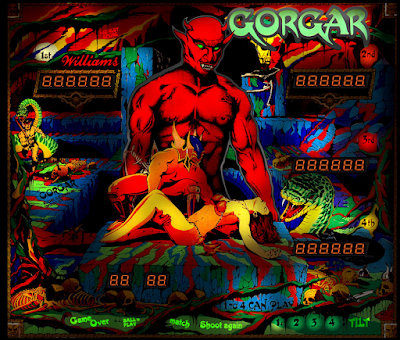
Then there’s Sorcerer. Seriously, look at this thing: https://pinside.com/pinball/machine/sorcerer/gallery It’s got that stoned 70s vibe, an image you once saw airbrushed on the side of a van. Hard to rip your eyes away.
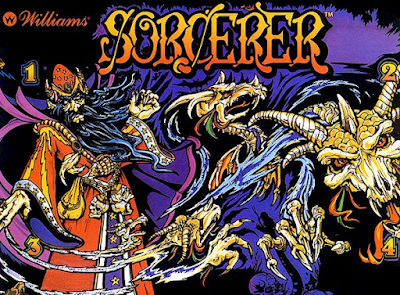
Centaur (1981) is absolutely balls-out as well. Take a listen to the voice and sound effects, a robotic “Destroy Centaur!” Incredible.
Even cooler, the centaur isn’t half man, half horse, it’s a half man, half motorbike. Wielding an axe. This can be none more metal.
This dude has it going on with Centaur in his game room (and don’t think I don’t see that collected edition of Captain America).
Apparently player demand for Centaur led to Centaur 2. This video gives a better look at the complex clockwork mechanisms underpinning the game. Pretty freaking cool.
A few others include
Paragon.
Black Knight (1980).
Seawitch.
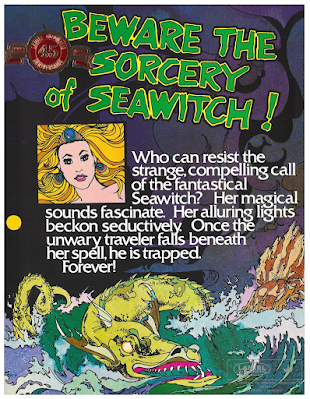
Absent any space restrictions I’d include Hercules, allegedly the world’s largest pinball machine. Which is reportedly lousy to play but sizewise it goes to 11.
Today everyone is playing fully immersive MMORPGs with photorealistic graphics and novel-quality storylines. I have no problem with this, even though I gave up video games long ago. But there is something about real steel and glass, painted cabinets and game boards and lightbulbs and rubber bumpers. The tactile, analog, reality of these games, that have huge appeal.
Further there is something about the aesthetic of the late 70s/very early 80s games in particular that grip me. The colors have that Frank Frazetta/Jeff Jones muddiness/dun pallor to them, yellows and tans mixed with splashes of bright red and pale gold. As you slide into the mid-and late 80s the cabinets are brighter, a bit more comic book bright and garish. There are still amazing games here but just a little bit outside of what I’m looking for. And while I’m no pinball historian the video game boom of the early 80s dimmed this golden age of the silver ball.
By the way this theoretical S&S game room is not restricted to pinball. I’d have Heavy Metal, Fire and Ice, Conan the Barbarian 1982 and Thundarr the Barbarian playing in a continuous loop on a projection screen. Perhaps Gauntlet in the corner, or Joust. And of course, a bar with a couple kegs of beer tapped 24-7. Which is dangerous … but sword-and-sorcery is not for the faint of heart, and ale must be quaffed in quantity.
My tastes are simple, Conan with a slight tweak:
Let me live deep while I live; let me know the rich juices of red meat and stinging wine on my palate, the hot embrace of white arms, the mad exultation of battle when the blue blades flame and crimson, and I am content. Let teachers and philosophers brood over questions of reality and illusion. I know this: if life is illusion, then I am no less an illusion, and being thus, the illusion is real to me. I live, I burn with life, I love, I play pinball, and am content.”
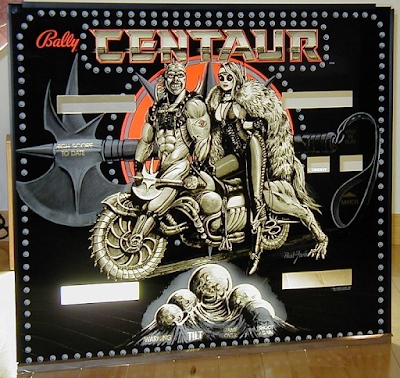
June 1, 2025
Three things
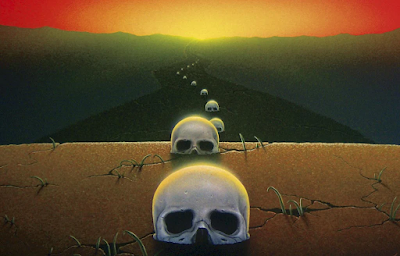 Walk with me...Thing 1
Walk with me...Thing 1I just finished re-reading The Long Walk after a long walk of my own, years and years of life since my last reading decades ago. Some thoughts.
We get no details on why the Walk came to be, just a couple scant suggestions. Like this: “In the old days, before the Change and the Squads, when there were still millionaires, they used to set up foundations and build libraries and all that good shit.” There is a reference to a war fought against a nuclear-armed Germany in 1953. So it’s not set in an apocalyptic future but some alternate history, perhaps one in which Germany develops an atomic weapon before 1945 and greatly extended the second world war. The result is a terrible totalitarian 20th century where the country is so lost and the future so bereft of hope that it turns to horrible death-fueled game shows to forget.
We don’t know, and I like it this way. Given the many chapter epigraph references to the Price is Right, prize fighting, and the Ten-Thousand Dollar Pyramid, I’m sure King was inspired by the game show craze sweeping the nation in the 1970s.
Things haven’t changed all that much. We all seem to be walking around in a fog, distracted just enough by digital spectacle to ignore the real horrors going on around us, as well as our own impending deaths. Just scroll an Instagram feed.
The Long Walk is an extended metaphor on dying. We’re all on the same Walk, two minutes from a ticket out (Walkers who slow their pace get three warnings before they are shot dead). That brief space tracks somewhat closely to what happens when you stop breathing. We’re separated from the other side by a thin margin. So we walk, and everyone around us drops off, one by one, until its our turn.
I know the literal, physical territory of this Walk, I was just on it, yesterday, when my wife and I had a nice dinner in Portsmouth, NH. The Walk starts in Maine, crosses into New Hampshire, and a skeletal handful make it all the way to my home state of Massachusetts. Weird, wild. Between King and H.P. Lovecraft New England takes a back seat to no other region of the United States when it comes to horror.
I really do enjoy King, in particular his old stuff. Say what you want about his long-windedness, his occasional closure whiffs and bad endings, and his lack of philosophical depth (King himself describes his work as the literary equivalent of a cheeseburger). I’d be hard-pressed to think of another writer who can so sweep you up into a story and hold you spellbound until the end. That’s true talent.
Thing 2
I’ve seen a few places—messageboards, articles, reddit threads—refer to the sword-and-sorcery definition I offered in Flame and Crimson as “seven points,” which makes it seem like a cumbersome checklist that must be met.
This is not correct, because it’s not what I wrote.
What I wrote was, sword-and-sorcery often contains these handful of elements; it does not need all of them nor any precise proportion. But shorn of any it’s hard to picture anyone calling said story S&S.
I kind of like this, it seems to me flexible and elegant, forgiving but not without boundaries. A precise definition of S&S is not really possible, IMO. When you look at how the subgenre evolved it coalesced over three decades and in conversations with authors and a fan community. It has changed and will continue to evolve. So instead of a precise definition I offered up a constellation of tropes. With the caveat that I am just a guy and YMMV.
See some of my other musings here.
But for some reason this seems to be a continued source of confusion and occasionally complaint. Some feel the need to simplify the definition, boil and boil down like maple syrup in some type of purity contest, until the definition of S&S might fit on the head of a pin.
If you must insist…I can’t boil it down to one word but I’ll give you two: Pulp Fantasy.
 I am this target audience.
I am this target audience.Thing 3
I mentioned Instagram further up; yesterday that platform triangulated me with precision, locked in with unerring heat detecting radar, launched its missile, and hit me with a dead-on bullseye.
The missile: A Fine Line Between Stupid and Clever: The Story of Spinal Tap. Signed by director Rob Reiner.
How did I not know this existed? The ad hit my feed. I preordered.
The takeaway: Algorithms work, and I too can be reeled in like a fish on a line.
May 30, 2025
Gods of War, Def Leppard
Steve Clark's guitar work on "Gods of War" produces this effect in me.
You never really hear much about this track. Although its on the wildly popular Hysteria, its greatly overshadowed by the lineup of mega hits on the rest of the album. Buried in the middle, an afterthought amid the seven (!) singles that dominated the charts.
But I find the guitar tone on "Gods of War" impeccable ... nostalgic, epic, beautiful.
Here's a live performance from 1988. Give it a listen and let me know if you agree. See 1:27 mark.
Sad that Clark left us just three years later but this is a legacy piece of work.
May 28, 2025
The Acts of King Arthur and His Noble Knights by John Steinbeck, a review
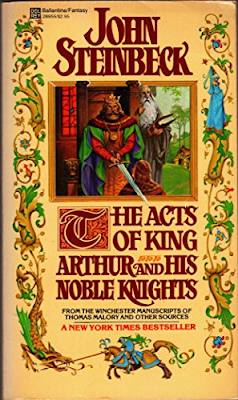 John Steinbeck is rightly remembered these days as a Pulitzer-prize winning author of The Grapes of Wrath and secondarily, East of Eden; almost no one talks about his foray into Arthurian myth.
John Steinbeck is rightly remembered these days as a Pulitzer-prize winning author of The Grapes of Wrath and secondarily, East of Eden; almost no one talks about his foray into Arthurian myth.Yet his heart lay in time-shrouded tales of questing knights and the shining castle on a hill. Steinbeck was ensorcelled by the stories of King Arthur his entire life. They were his gateway to a true love of reading at age 9, and from youth all the way to his death in 1968 the stories of King Arthur were never far from his mind.
Steinbeck embarked on his own spin on Malory’s Le Morte D’Arthur, writing The Acts of King Arthur and His Noble Knights in a two-year period from 1958-59. Sadly the book was never finished … but that doesn’t mean you shouldn’t read it.
You should. I just did, and I’m better for it.
The King Arthur stories are not (just) stories of dudes in armor riding off on great quests. They are part of our western literary canon, but even more so, part of the fabric of western myth. They instruct us how to behave, but also where we fall short.
And so we have passages like this (cue Nicol Williamson); not a celebration of our species’ predilection for violence, but certainly a good as explanation of any as to why we’re still fighting wars in the 21st century in the shadow of millions of heaped corpses still fresh from the 20th:
“Then Arthur learned, as all leaders are astonished to learn, that peace, not war, is the destroyer of men; tranquility rather than danger the mother of cowardice, and not need but plenty brings apprehension and unease. Finally he found that the longed-for peace, so bitterly achieved, created more bitterness than ever did the anguish of achieving it.”
Here is Steinbeck’s Merlin, wise beyond comprehension to the point of being able to see the future, yet he too is subject to the lusts that rule men, falling helplessly under the binding spell of Nyneve:
“In the combat between wisdom and feeling, wisdom never wins. I have told you your certain future, my lord, but knowing will not change it by a hair. When the time comes, your feeling will conduct you to your fate.”This is a tale of many characters but Launcelot is the central figure; Launcelot who is the best of all knights, but of course with a fatal flaw; who despite his love for Guinevere wins every bit of our admiration because when asked if he is content to be the world’s perfect knight the question nearly splits him in two before he regains his composure. This internal struggle is rendered beautifully by Steinbeck:
A black rage shook Sir Launcelot, drew his lips snarling from his teeth. His right hand struck like a snake at his sword hilt and half the silver blade slipped from the scabbard. Lyonel felt the wind of his death blow on his cheek.
Then, in one man he saw a combat more savage than ever he had seen between two, saw wounds given and received and a heart riven to bursting. And he saw victory, too, the death of rage and the sick triumph of Sir Launcelot, the sweat-ringed, fevered eyes hooked like a hawk’s, the right arm leashed and muzzled while the blade crept back to its kennel.
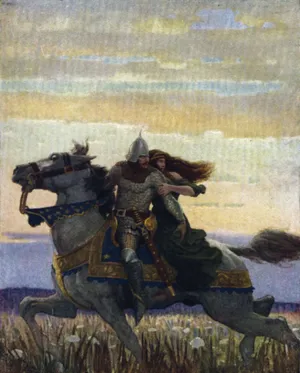 Lancelot and Guinevere.Launcelot is if not the “greatest” knight the most sympathetic, because he wrestles with his conscience and occasionally fails, yet never relents. Unlike the perfect Galahad who recovers the grail, for Lancelot every day is a battle that leaves him bone-weary, either with foes eager to test their mettle or against his own weaknesses—vanity, violence, disloyalty. And yet we love him for it, as does his young cousin and knight in training Sir Lyonel:
Lancelot and Guinevere.Launcelot is if not the “greatest” knight the most sympathetic, because he wrestles with his conscience and occasionally fails, yet never relents. Unlike the perfect Galahad who recovers the grail, for Lancelot every day is a battle that leaves him bone-weary, either with foes eager to test their mettle or against his own weaknesses—vanity, violence, disloyalty. And yet we love him for it, as does his young cousin and knight in training Sir Lyonel:Sir Lyonel knew that this sleeping knight would charge to his known defeat with neither hesitation nor despair and finally would accept his death with courtesy and grace as though it were a prize. And suddenly Sir Lyonel knew why Lancelot would gallop down the centuries, spear in rest, gathering men’s hearts on his lace head like tilting rings. He chose his side and it was Lancelot’s.This is a book of quests, and one of my favorites is when Lancelot confronts a broken Kay, who used to be a great champion but is now a shell of his former self. Lancelot asks him why he has fallen; Kay explains the weight of responsibility, and the mundane, soul-crushing management required of a kingdom:
“Granite so hard that it will smash a hammer can be worn away by little grains of moving sand. And a heart that will not break under the great blows of fate can be eroded by the nibbling of numbers, the creeping of days, the numbing treachery of littleness, of important littleness. I could fight men but I was defeated by marching numbers on a page.”I suspect a modern office middle manager, or Kull at his writing desk, would be nodding his head sagely. Lancelot does as any good friend should; he dons Kay’s armor and shield and rides out to knock a hundred men off their horses and send them groveling back to Arthur’s court to submit to the queen as Kay’s prizes, unbeknownst they were fighting the greatest knight in the land.
The Acts of King Arthur and His Noble Knights is of course notably unfinished, published posthumously in 1976; leading one to speculate. Did Steinbeck finally lose interest in Arthur? Was it becoming tedium, because the story was not his and he knew how it would end? Could he not bear to engage in the full measure of tragedy in a time when he and his wife were reportedly at their happiest?
We don’t have an answer. In its early stages Steinbeck described it as the greatest work of his life. Keep in mind this was late in his career, AFTER all his major works were completed.
It is perhaps fitting the story ends with a kiss, perhaps the most passionate and illicit in western literature. From there it’s all downhill for Camelot. Perhaps Steinbeck did not wish to deal with the full measure of the tragedy. Which seems unlikely given the tragedy in his better known literary works, but Le Morte D’Arthur is the big daddy of tragedy.
We can only guess. But I’m glad we have what we have. Highly recommended.
A few notes: Because it was unfinished and Steinbeck indicated that it took him some time to get down the style, he intended to go back and do rewrites. As such it’s a uneven to start and does not truly get going until the Morgan Le Fay chapter about 100 pages in. Up until then it feels like a beat-for-beat translation of Le Morte D’Arthur with updated diction, but at that point takes on something of the pace of a modern novel.
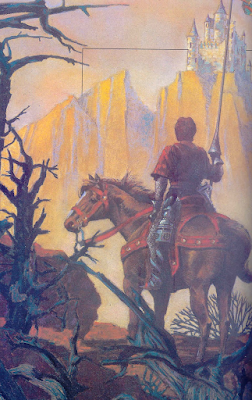 A perilous quest...Most critics then and now did not care for the book, mainly because they were expecting something much more Steinbeck and not a faithful adaptation/quasi translation of Malory. Steinbeck’s agent was puzzled upon seeing an early draft, leaving him stung by the reaction. Perhaps they were expecting a family of migrants on a dusty trek/quest to California, riding flatbed trucks instead of chargers? That does sound cool come to think of it but not what we get here. I suspect Steinbeck held Le Morte D’Arthur in such reverence he found no need to try to improve upon it; he set out to tell the same story in plainer English and IMO for what we have, succeeded.
A perilous quest...Most critics then and now did not care for the book, mainly because they were expecting something much more Steinbeck and not a faithful adaptation/quasi translation of Malory. Steinbeck’s agent was puzzled upon seeing an early draft, leaving him stung by the reaction. Perhaps they were expecting a family of migrants on a dusty trek/quest to California, riding flatbed trucks instead of chargers? That does sound cool come to think of it but not what we get here. I suspect Steinbeck held Le Morte D’Arthur in such reverence he found no need to try to improve upon it; he set out to tell the same story in plainer English and IMO for what we have, succeeded. He might also have felt like the original stories were being lost. In an age of radical literary experimentation and increasing Hollywood exploitation (then and now) he was not wrong.
My edition has a wonderful series of letters at the back, most from Steinbeck to his literary agent or his longtime friend. These offer terrific insight into his first-person research that included trips to Wales, Glastonbury, Tintagel and other places associated with Arthur. We get valuable insight into Steinbeck’s writing process, including his struggles to find the right literary voice and approach, eventually settling on “a close-reined, taut, economical English, unaccented and unlocalized … it just as simple as that and I think it is the best prose I have ever written,” Steinbeck says. And everywhere his love of Malory that shines through any faults he found in the original. Steinbeck was very well versed in the old stories and I enjoyed reading his own analyses of the myth, as here where he compares the stories to modern televised westerns:
And it can be shown and it will be shown that the myth of Arthur continues even into the present day and is an inherent part of the so-called “Western” with which television is filled at the present time—same characters, same methods, same stories, only slightly different weapons and certainly a different topography. But if you change Indians or outlaws for Saxons and Picts and Danes, you have exactly the same story. You have the cult of the horse, the cult of the knight.Steinbeck felt the profound human truths at the heart of the story, truths which transcend time and place, and sought to preserve it whenever possible. This is not George R.R. Martin’s Game of Thrones, it is something much older and in my opinion, far deeper. It will endure the ages. To close with Steinbeck: “I am not writing this to titillate the ear of the twentieth century. Perhaps I am overambitious, but I am trying to make it available, not desirable. I want the remote feeling of the myth, not the intimate feeling of today’s man who in his daily thought may change tomorrow but who in his deeper perceptions, I am convinced, does not change at all. In a word I have not been trying to write a popular book, but a permanent book.”
***
A few other thoughts about Arthuriana.
When talking about the north stars of fantasy most seem to skip the King Arthur stories. If I had to speculate, it’s because they occupy some liminal space between mythology, history, and national epic. You can’t really compare Sir Thomas Malory with Dunsany or Tolkien, Howard or Leiber, Lewis or LeGuin, Martin or Rowling.
But of course they are largely fantasy, replete with spells and giants and magic swords. And if you choose to classify them as such, it’s hard to think of anything more fantastic.
May 19, 2025
A crisis of artificiality
The world is getting increasingly artificial. And by world, I mean the online spaces most of us inhabit for many/most of our waking hours.
I'm starting to wonder if knowledge and expertise as we know it isn't being rewritten and entirely outsourced to machines. I plan to post about some increasingly disturbing trends I'm seeing.
I'm glad I wrote Flame and Crimson before generative AI, lest I be accused of having a machine do the work. I'm not using AI at all in my WIP metal memoir, either.
I'm not anti-AI. I think this tech has massive positive potential for humanity. In my own professional niche I've seen how it can for example allow physicians to offload burdensome documentation requirements and restore sanity to a burned out, overworked profession.
But I think in the creative realms gen AI something close to a cancer. It's definitely slop.
You will never see ChatGPT generated text on this blog. Or generative AI images.
I value human beings and authentic creativity, the product of human minds and souls. It's why I revere live performances and continue to attend them. I believe in human beings, as fucked up and flawed as we often are.
May 17, 2025
We are called to live: A night with Wildside in Dracut MA
 Take a ride on the Wildside. Many/most 50+ year-old men were probably at home watching the Celtics playoff game last night. I was called back to the 1980s, and fantasy, and a late night with Wildside.
Take a ride on the Wildside. Many/most 50+ year-old men were probably at home watching the Celtics playoff game last night. I was called back to the 1980s, and fantasy, and a late night with Wildside.I decided on the spur of the moment to see an 80s hair band tribute. They were playing at a place called The Boat in Dracut, where I’d never been. I felt the call. On Thursday I texted my buddy Wayne, whom I’ve known since grade school and has been my wingman at countless metal shows. Yesterday he let me know—he was in. The night was on.
I never go to Dracut. I have never had a need to go to this odd town far off any major interstate, accessible only by driving through 20 minutes of woods and farmland. Which feels like undiscovered Lovecraft country in a state this small. I navigated past rusted grain silos and empty fields and then battered mill buildings and then I was there.
The Boat as it turns out is located on the shore of Mascuppic Lake. To be frank it looks like shit on the outside, a haphazardly maintained concrete bunker with a weathered deck. You have to pass through a steel door to enter.
 Meat Raffle ... and WildsideI knew I was in for a Spinal Tap sort of evening when I pulled into the parking lot, cut the engine, and glanced up at the marquee. Top billing was given to a Meat Raffle, with Wildside the second act. Had there been a puppet show Wildside would have been no. 3. I insisted Wayne take my picture in front of it, and wouldn’t you know it I had remembered to wear my Spinal Tap shirt.
Meat Raffle ... and WildsideI knew I was in for a Spinal Tap sort of evening when I pulled into the parking lot, cut the engine, and glanced up at the marquee. Top billing was given to a Meat Raffle, with Wildside the second act. Had there been a puppet show Wildside would have been no. 3. I insisted Wayne take my picture in front of it, and wouldn’t you know it I had remembered to wear my Spinal Tap shirt.Inside it was the place to be, if you like blonde women in tight leather pants swaying on the dance floor. Or overweight dudes, one wearing a Kix t-shirt and another a sleeveless denim vest with “The Warriors” emblazoned on the back. That Warriors, of the 1979 film. Very dark, biker-ish, but clean and well maintained, with a great center stage where the action unfolded.
Wildside was great. The lead singer is Ron Finn, who also sings for a Judas Priest tribute band I twice hosted at my home. I am very familiar with his work. The guy can sing, with a wonderful stylistic range and high top-end register that works for everything from “Still of the Night” to “Lick It Up” to “Screaming in the Night” (Krokus). And everything in between. AC/DC and Guns-and-Roses, Van Halen, and some fantastic Def Leppard covers.
We heard it all, listening after midnight. Here's an upload from my phone, an excerpt of "Bringing on the Heartache."
Women and some men swayed on the dance floor, thrust fists to the heavens, air guitared along to the break in “Running With the Devil.” I did too.
A thought crossed my mind: Should I be home? No. Not for a $10 cover charge. Budweisers are $4.50. Tripoli’s beach pizza cooked hot, topped with a slice of melted provolone cheese for $5. That’s fucking living right there. I need nothing else.
Looking around, I know it’s all ridiculous. But life is ridiculous. I am ridiculous. And I love it. I love it all.
I’m going to wring every fucking last drop out of life. Why else are we living?
I am never so alive than when I’m at a metal show. I feel electric.
It’s worth the 1 a.m. bedtime next-day fatigue and the dry mouth hangover.
Don’t pass it up. Go to the show. Live.

May 16, 2025
Sixteenth Century Greensleeves, Rainbow (RIP Ronnie James Dio)
Fifteen years ago today we lost the great Ronnie James Dio. As time passes my appreciation of his music only grows.
Here’s a deep cut from his Rainbow days on this Metal Friday. Listen to the lyrics of this one, S&S fans. This is where Dio fully tapped the vein of fantastic source material that would be the hallmark of his career.
Meet me when the sun is in the western sky
The fighting must begin before another someone dies
Crossbows in the firelight
Greensleeves waving
Mad men raving
Through the shattered night
Flames are getting higher
Make it leap unto the spire
Drawbridge down
Cut it to the ground
We shall dance around the fire
Also, if anyone happens to be in Dracut tonight (obscure MA town/what are the odds? But you never know if you don’t ask), I’ll be at The Boat to take in Wildside, an 80s tribute band fronted by Ron Finn. I’ve known for Ron some years now and he’s twice played live in my home. In addition to a great Rob Halford he can do David Coverdale, too.
May 13, 2025
Here's something cool: Tom Barber painting donated to Andover (NH) public library

On April 26, my friend Tom Barber--an Andover NH resident and a well-known painter and illustrator since the 1970s, presented his painting of "The Bibliophile" to Michaela Hoover, director of the Andover Libraries. The painting, which shows an imaginary book lover immersed in his favorite pastime, was donated to the libraries by an anonymous collector of Tom's works. It will hang in the Andover Public Library as an inspiration for book lovers of all ages.
For more information, visit https://www.andovernhlibraries.org/ or contact Tom at [email protected]
Also, Tom is still doing great work and would love to hear from you about commissions or other art projects.
May 11, 2025
Rock and metal shows starting to accumulate
When the year began I had just one show on schedule, Ace Frehley on Jan. 30 at the Tupelo Theater in Derry, NH. Possibly a second in Lotus Land, a Rush tribute, though that might have been an early year purchase.
After committing to Blind Guardian on Wednesday, Nov. 26 at the Worcester Palladium a couple days ago, I’m up to eight. In this age of artificiality I crave live performances. I need a regular metal and hard rock fix, and Spotify alone doesn't cut it.
I’ve never seen Bruce Dickinson solo so that one intrigues me the most. Hairball (a band that covers various 70s-80s metal acts, including costumes etc.) should be a blast in a wild venue. Foreigner’s Journey is another tribute act of, as you might guess, both Foreigner and Journey. I’ve seen them once before and the lead singer sounds uncannily like Steve Perry, less like Lou Gramm.
And yes, I did see Ace Frehley 2x this year. I might yet add 1-2 more (shows, not Ace Frehley).
Thursday, Jan. 30
Ace Frehley
Tupelo Theater, NH
Friday Feb. 14
Lotus Land
Cabot Theater, Beverly
Saturday March 15
Ace Frehley
Blue Ocean, Salisbury
Friday June 13
Foreigner’s Journey
Blue Ocean, Salisbury
Thursday Sept. 11
Bruce Dickinson
Citizens House of Blues, Boston
Friday Sept. 26
Judas Priest and Alice Cooper
Holmdel, NJ
Saturday Oct. 11
Hairball
Hampton Beach Ballroom Casino
Wednesday Nov. 26
Blind Guardian
Worcester Palladium
May 7, 2025
Robert E. Howard, The Life and Times of a Texas Author: A review
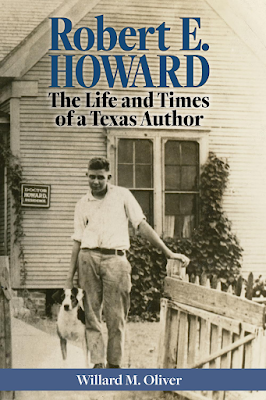 How do you review a new Robert E. Howard biography? Perhaps with the question: Do we need a new Howard biography? After all, we have two major works already: L. Sprague de Camp’s Dark Valley Destiny and Mark Finn’s Blood and Thunder. There are others too, which I have not read and cannot comment on: David C. Smith’s Robert E. Howard: A Literary Biography, and Todd Vick’s Renegades and Rogues: The Life and Legacy of Robert E. Howard.
How do you review a new Robert E. Howard biography? Perhaps with the question: Do we need a new Howard biography? After all, we have two major works already: L. Sprague de Camp’s Dark Valley Destiny and Mark Finn’s Blood and Thunder. There are others too, which I have not read and cannot comment on: David C. Smith’s Robert E. Howard: A Literary Biography, and Todd Vick’s Renegades and Rogues: The Life and Legacy of Robert E. Howard. The field seems well sewn. But let’s dig a little deeper. DVD is well-researched and eminently readable but ultimately a flawed work. It places its emphasis on Howard’s psychology, starting from a place that there must have been something wrong with REH and then building that case with outdated and clumsy psychoanalysis (for more, see here).
If Dark Valley Destiny frames REH’s life as a story of tragedy, a literal Dark Valley from which there was no escape, Finn’s Blood and Thunder is a thunderous corrective. Its strength is its compelling case as Howard as Texas writer, a young man who drew from his surroundings and the recently closed Texas frontier to give us pulp adventure that shows every sign of literary immortality. It’s also a cracking good read by a born raconteur. What it does lack is scholarly apparatus, footnotes and avenues for further research.
So yes, you can make the case for new Howard biography. Williard M. Oliver has added a new voice and a new chapter in Howard scholarship with the newly released Robert E. Howard The Life and Times of a Texas Author (University of North Texas Press, 2005). And I’m happy to report it’s very good.
Oliver’s biography is not a middle ground between DVD and B&T but instead cuts a new channel—scholarly biography, as exhaustively researched as DVD and as fair as Finn’s reappraisal. It’s a substantial book, more than 500 pages counting references and works cited. The heart of the book is Oliver’s theory that Howard’s desire for personal freedom was the motivating force of his life and writing career, perhaps the apex in his personal hierarchy of values: “I have but a single conviction or ideal, or whateverthehell it might be called: individual liberty. It's the only thing that matters a damn” (letter to H.P. Lovecraft, 1932).
And yet as deeply as Howard strove for freedom another value equally as powerful presented a formidable counterweight: The call of community. This was chiefly apparent in Howard’s obligation to provide care for his ailing mother and her battle with tuberculosis. Howard depended on a literary community of magazine editors and loyal readers. And finally, he desired a meaningful relationship with Novalyne Price Ellis, one he was ultimately denied. When Price asked REH to delegate his mother’s care to nurses or other paid help Howard refused: it was his obligation. Oliver paints an arresting scene in which Howard, out driving on a date, slams on the brakes of his car, telling Price, “I want to live! I want a women to love, a woman to share my life and believe me, to want me and love me. Do you know that?”
Values dissonance can result in emotional growth and meaningful change, but generally only after a crisis. Howard was unable to reconcile the opposition of personal liberty and communal obligation and his mother’s death provided the way out.
Robert E. Howard The Life and Times of a Texas Author gives us all of this, all of Howard’s life, in probably as much detail as any fan could want.
Following are some of the details and bits I enjoyed, either because they're well-presented, interesting, and/or new (to me).
Oliver does a fine job setting up Howard’s time and place—the actual town of Cross Plains. It offers rich detail of his family history/parents and settlings in United States. There is some great material here on Howard the poet—his love of verse, his early sales, and being one of the most prolific poets in WT history. Howard’s poetry even received rare praise from mercurial Weird Tales editor Farnsworth Wright. Fans often forget this or overlook his wonderful poems.New to me; Howard’s deliberate construction and cultivation of an Irish identify (pp. 197-198); I knew about his strong Gaelic interests but not how far he adopted them into his own life—singing old Irish songs, Gaelicizing his middle name, etc.His youthful, beer-swilling trips with Smith and Vinson as detailed in the Junto (p. 215), told her evocatively and dude-bro awesome by Oliver.Oliver does a nice job introducing “The Shadow Kingdom” and its important place as the origin of sword-and-sorcery but also one of Howard’s most poetic and vivid stories, as well as how popular it was with WT readers and editors (my ego is pleased to find myself cited here, and elsewhere, in the work—pp. 245-246).Howard’s fatiguing medical condition is covered here with more research, care and nuance than DVD.There are several new pics of REH I had not seen before. This was a very pleasant surprise.We get some well-placed details on the Great Depression, focused on Cross Plains and the closure of its two banks in 1931 (p. 308).Howard’s love of westerns and the role of the frontier in his books. Although he wrote straight two-fisted westerns he also wrote some weird westerns, a genre for which he is considered the founder (p. 315)I enjoyed the detail on Margaret Brundage’s artistic process. A prolific cover artist for Weird Tales, she would actually read the stories, pick the scenes that seemed most salacious/sexy, draw them using pastel chalk on canvas, and tack the image to a wooden frame before dropping them off at the WT office (p. 338).Black Mask, Dashiell Hammett and the birth of hard-boiled detective, meting out tough personal justice outside the law. Howard wrote his own hard-boiled detective stories but never loved the form and it was his least successful literary foray (p. 350).Howard getting half-checks from a struggling Weird Tales before these too ceased due to the magazine’s financial woes (p. 412). If I had read before that WT was cutting Howard half-checks with the promise to pay the rest later if so I had forgotten this detail.Howard’s love for the landscape Texas and its barbarian ethos, which likely would have been his next literary venture (p. 436).Oliver’s speculation that Hester’s death provided the occasion for Howard’ suicide and was not necessarily the inciting incident; I agree, though would add it was the result of an irreconcilable clash of values (p. 455).Details about a will Howard wrote near the end of his life which reportedly bequeathed all his worldly possessions to friend Lindsey Tyson. And destruction of said will. Oliver says this may have been gossip, not fact.A nice summation of Howard’s character by Price and his circle of friends and WT collaborators, post-suicide This was sad, especially the remembrances and posthumous praise in letters to the Eyrie from heartbroken WT readers (p. 466).
Does the book contain any flaws? From a research perspective I cannot say; I’m not a Howard scholar and lack the qualifications to fact-check a book with this level of detail. But everything I read seemed accurate and, as noted, Oliver provides voluminous references for cross-checking. It perhaps is a little slow to start; try as I might I’m just not interested in genealogy and so I found the early chapters a bit dry. If Oliver is not as colorful a writer as DeCamp or Finn he’s certainly economic and journalistic and his style is very accessible (which is in itself, an art). The book does not delve into Howard’s racism, which is fair enough, as IMO it does not transcend its time and place and is therefore unremarkable. I imagine some might criticize this decision. There is little to no post-mortem discussion of REH’s legacy, but as Oliver himself states that’s a story requiring a book-length work of its own. The price of the hardcover may be steep for casual fans, as is its length, but I doubt many casuals will pick it up.
In summary, any criticisms I have are minor. I believe Robert E. Howard The Life and Times of a Texas Author will join the front ranks of Howard scholarship; I can’t see another Howard biography surpassing this one for research, even-handedness, and thorough attention to detail. Time will tell.



